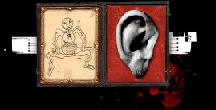What is it?
Let me say right from the
start, I hated EVIDENCE: The Last Ritual almost from the first
moment I started playing it. Okay, that’s the conclusion written. Now I
have to tell you why.
First of all the simple
facts: EVIDENCE: The Last Ritual (just Evidence from now on)
is presented in what looks like a police forensic evidence bag, containing
a large multi-compact-disc case. It's labeled to look like it's evidence
collected by the New York Police Department for the FBI, but is actually
published by The Adventure Company, having been developed by
Lexis Numerique.
The box contains four CDs: three installation discs and one play disc. The
manual is a PDF on Disc 1, which is also the play disc.
Is there
a plot?
The story of Evidence
revolves around a serial murderer called the Phoenix, who was first
brought to the public attention through Missing: Since January.
This time he's (assuming the Phoenix is a 'he') killing people for some
sort of ritualistic purpose. He's not a shy sort, this Phoenix. The CDs of
the game are from him and they contain videos of two teams investigating
two different cases: one of gruesome murders, and one of a missing person.
However, access to these videos is controlled through a complex series of
puzzles.
How do
you play?
The game launches in a full
screen view, dominated by black. Technically, Evidence appears to
have been written in Flash. This has the serious advantage that you can
alt-tab back and forth to the game with ease, with no risk of it causing
the sorts of crashes so often seen in more complex 3D games. Of course
this is just as well, because you’ll be doing this a great deal during the
course of play.
The first stage of play is to
register yourself with the ICPA (International
Committee for the Phoenix Arrest)
via the User Email
Management screen, from which point onwards you’ll receive numerous emails
(I counted 128, but there could be more) containing so-called ‘hints,’
comments on your progress, and, most annoying of all, the ‘where are you?’
emails. If I want to play your game,
Lexis Numerique, I’ll play it
when I want to, not when you beg me and try to guilt-trip me into playing.
Now get the heck out of my Inbox!
Sorry, a bit of venom
overflow there.
The first email you’ll
receive is actually useful – it contains your password to play, without
which you cannot proceed. So, obviously, you should use a real email
address, not that joe.bloggs.nospam@aol.com bogus email address you’ve
been using on all those new site registrations!
Right. Now we’re in, this is
where it starts getting tricky (a word here that means as frustrating as
feeding pills to cats. Hint: try Googling ‘How
to give a cat a pill’). Don’t worry, Google
is your friend, Google has the answers, bookmark Google, you’re gonna need
it! Apologies to those who don’t use Google as their search engine of
choice already, but you’ll probably have to get used to it for a while, as
I don’t know if any of the other search engines of note have quite the
same coverage of the sites you’ll need.
The puzzles are arranged in
levels, each one containing four or five puzzles named for the Egyptian
astrological ‘Decans.’ Some of the puzzles are also divided into
sub-puzzles. The menu screen for each level has a fuzzy animation in the
middle, and four or five squares moving quite rapidly up and down the
right-hand side of the screen. At this point I shall bring up another area
of frustration with this game: mouse control.
Evidence
is largely mouse controlled, so although puzzle solutions are often typed
into text boxes on-screen, you’ll often be chasing small moving objects
on-screen with the mouse pointer. You need the eyesight of a
twelve-year-old and the mouse control of a cat to keep up. Despite
appearing to be a research/puzzle quest, the level of hand-eye
coordination (not to mention visual and aural acuity) required for this
game puts this on a par with some first-person shooters! Definitely not
one for anyone using the accessibility features of Windows.
Early in the game, puzzle
solutions are usually the result of user action in solving the on-screen
conundrum, but as the game progresses, the on-screen material only
provides clues as to the correct answer. Many of the puzzles can only be
solved by taking those clues from the game, and from the emails, and
searching for answers on the Internet. This opens its own can of worms in
terms of frustration, of course. If you’ve gleaned only part of the clues
from the game (including the content of the videos opened by various
puzzles), then you’re in for a whole heap of frustration searching through
every piece of the
conspiracy-theory-laden, suppressed-hidden-meaning claptrap that goes with
the modern 'study' (or perhaps that's 'fiction') about the European Middle
Ages.
Character Interaction
This game purports to make
you part of an international effort to hunt down a serial killer. This is
so anti-procedural as to make a joke of the whole thing. At no point do
any of the investigators come across as competent or intelligent. In fact
they’re so bad that they don’t even appear to consider trying to track
movements of victims and suspects through the travel companies, airports
and ferry ports, with their modern security checks.
The characters with which you
interact are brought to you through email. In fact, the ICPA website even
goes as far as to suggest that you’re part of an Internet community. This
might be the case, though I never tried to partake. The unfortunate result
of the setup is that some of the emails read like people that want to be
friends with you. This is a very confusing and concerning use of the
Internet – there is no telling what sort of impact this kind of
personalization of such a psychologically ambiguous experience could have
on someone with real-life/net-life balance issues.
Oddities
Given my comments up to now,
you’re probably expecting me to have another rant about how frustrating
Evidence is. Well, not just yet; that’s in the conclusions below. For
now, I will content myself by commenting on some of the positive features
of the game.
Yes, there are some, and in
the context of this review they qualify as Oddities!
Technically, this is a very
well constructed game. It was bulletproof in terms of reliability and lack
of glitches, even on my not-so-high-spec laptop. The music was
atmospheric, the sound effects suitably grating and dark. The imagery was
certainly effective in setting a frightening tone. That Phoenix is one
sick individual. Please note at this point, that Evidence is rated
Mature, and they mean it! There are gory murder scenes, scenes of the
simulated results of torture, and plenty of generally threatening
unpleasantness from the Phoenix himself in the form of emails.
Conclusions
EVIDENCE: The Last Ritual
is a game. Did you get that? It’s a game. No more, no less. It doesn’t
install root-kit software on your PC. It doesn’t make you part of an
international crime solving network. There are no real downloadable
additions or hacking tools involved. It’s a game. It’s a sham. It is
fiction.
As for a grade? I’m not going to grade this one because,
in technical terms, Evidence is well executed and bug free, as far
as I can tell. That makes it a high quality product. But there is no way I
can award more than a D for a game that I absolutely hated playing. I had
to drag myself to the laptop every time I resolved not to fail to complete
it, walkthrough to hand for most of the last three levels (including the
end game).
Playing Evidence was like having teeth pulled.
Grade: N/A
What do you need to play it?
Minimum Requirements
-
Operating System:
Windows® 98/2000/XP
-
Processor:
800 MHz Pentium® 3
-
RAM:
256 MB
-
Sound Card:
Sound Blaster® Compatible
-
Graphics Card:
32 bit
-
CD/DVD-ROM:
8x
-
Hard Disk Space:
2.5 GB
-
Internet:
56.6 Kbps Modem and Web Browser
-
Additional Software:
QuickTime™ 6.1 and Shockwave Player 8.5, both on install disc 3.
Recommended Requirements
-
Operating System:
Windows® XP
-
Processor:
1 GHz Pentium® 3
-
RAM:
512 MB
-
Sound Card:
Sound Blaster® Compatible
-
Graphics Card:
32 bit
-
CD/DVD-ROM:
16x
-
Hard Disk Space:
2.5 GB
-
Internet:
DSL or Cable Connection and Web Browser
-
Additional Software:
QuickTime™ 6.1 and Shockwave Player 8.5, both on install disc 3.
(I used a Dell laptop PC with
Windows XP Home running on an Intel Celeron M 1.6GHz, with 1024 MB RAM,
and a 128MB Mobile Intel 915 video card)
December 2006
design copyright ©
2006
GameBoomers
Group



